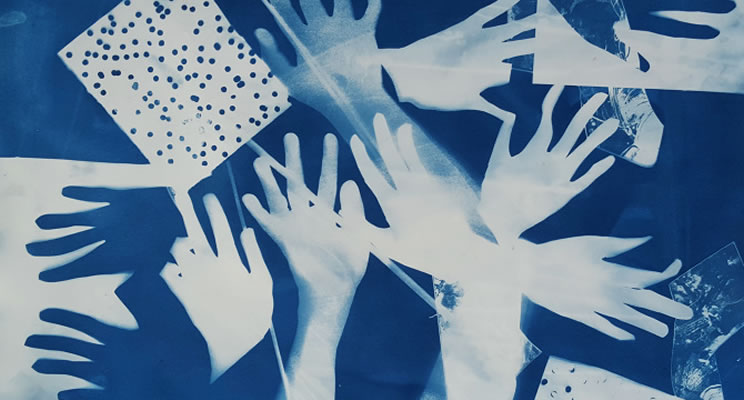August 11 program explores creative photography and photo making
Apple Valley, CA – A new exhibit at the Victor Valley Museum “Impressions of Blue Cut: Ruins/Renewal” provides the inspiration for the August 11 edition of Second Saturdays. The monthly program, launched in July, takes place the second Saturday of every month with a different theme. At the August Second Saturdays, visitors will have the opportunity to experiment with photography using pinhole cameras and making cyanotype prints. The museum’s exhibit, a photographic essay by Benoit Malphettes, showcases the skills and creativity of a world-renowned photographer.
Participants will compose objects on cyanotype paper and wait for the images to develop in the sunlight. The resulting images can be compared to the digital prints created by Malphettes. This investigation of early photographic processes will also include visiting the early cameras on exhibit in the museum’s history section. The program will be facilitated by Chris Trefrey, an award-winning professional photographer educated at the Brooks Institute of Photography in Santa Barbara, California.
Pinhole cameras are simple box cameras with a tiny hole in one side. When light from a scene passes through the hole, the image is projected on the other side of the box – inverted! The effect is the same as a camera obscura, a phenomenon known since the 5th century BC and described in detail by Leonard Da Vinci in 1490. Early camera obscuras were large, dark rooms used for astronomical observations. They later developed into devices used as drawing tools, or as rooms used for entertainment at seaside resorts. By the 1800s, inventors were adding light-sensitive film to camera obscuras and photographic cameras were born.
Cyanotypes, invented in 1842, are contact prints that are also called blueprints. Shortly after they were invented, Anna Atkins, one of the few women in photography in the nineteenth century, published the first book with photographs instead of illustrations: “British Algae: Cyanotype Impressions.” Cyanotypes are created with chemicals that are sensitive to ultraviolet light, so sunlight can be used for exposure—a perfect medium for the High Desert.
The program runs from 12 to 3 p.m. and is included with museum admission. “Second Saturdays at the Victor Valley Museum” focus on Victor Valley Museum collections and exhibits, with an emphasis on High Desert cultural and natural history.
Upcoming Second Saturdays @ the Victor Valley Museum will include other family art-making activities, water conservation gardening, rocks and minerals, reptiles, and fossils.
Second Saturdays @ the Victor Valley Museum and the County Museum’s other exciting events and exhibits reflect the effort by the Board of Supervisors to achieve the Countywide Vision by celebrating arts, culture, and education in the county, creating quality of life for residents and visitors.”
The Victor Valley Museum is a branch of the San Bernardino County Museum located at 11873 Apple Valley Road in Apple Valley. The museum is open Wednesday through Sunday from 10 a.m. to 4 p.m. Admission is $5 (adult), $4 (senior or military), and $2.50 (student. EBT cardholders are $1. Children under 5 and San Bernardino County Museum Association members are free. Parking is free. For more information, visit www.sbcounty.gov/museum. The museum is accessible to persons with disabilities.

